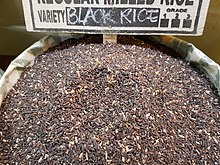കറുത്ത അരി
ഒറിസ സാറ്റിവ എന്ന ഇനത്തിൽപ്പെടുന്ന ഒരു തരം അരിയാണ് കറുത്ത അരി. പർപ്പിൾ റൈസ് എന്നും ഇത് അറിയപ്പെടുന്നു. അവയിൽ ചിലത് ഗ്ലൂട്ടിനസ് അരിയാണ്.



കറുത്ത അരിയുടെ നിരവധി ഇനങ്ങൾ ഇന്ന് ലഭ്യമാണ്. ഇന്തോനേഷ്യൻ ബ്ലാക്ക് റൈസ്, ഫിലിപ്പൈൻ ഹെയർലൂം ബലാറ്റിനാവ് ബ്ലാക്ക് റൈസ്, പിറുരുതോംഗ് ബ്ലാക്ക് ഗ്ലൂട്ടിനസ് റൈസ്,[1][2] തായ് ജാസ്മിൻ ബ്ലാക്ക് റൈസ് എന്നിവ ഇതിൽ ഉൾപ്പെടുന്നു. ഇന്ത്യയിലെ മണിപ്പൂരിൽ കറുത്ത അരി ചക്-ഹാവോ എന്നറിയപ്പെടുന്നു.
ബംഗ്ലാദേശിൽ, ഇത് കാലോ ധനേർ ചാൽ (കറുത്ത നെല്ലരി) എന്നറിയപ്പെടുന്നു. ഇത് പുലാവ് അല്ലെങ്കിൽ അരി അടിസ്ഥാനമാക്കിയുള്ള മധുരപലഹാരങ്ങൾ ഉണ്ടാക്കാൻ ഉപയോഗിക്കുന്നു. കറുത്ത അരിയുടെ തവിടുപൊടിയിൽ (അറ്റത്തെ പാളി) ഭക്ഷണത്തിൽ കാണപ്പെടുന്ന ഏറ്റവും ഉയർന്ന അളവിലുള്ള ആന്തോസയാനിനുകളിലൊന്ന് അടങ്ങിയിരിക്കുന്നു. [3] ധാന്യത്തിന് ഉണക്കലരിക്ക് സമാനമായ അളവിൽ നാരുകൾ ഉണ്ട്. ഉണക്കലരി പോലെ, ഇതിന് നേരിയ അണ്ടിച്ചുവയുള്ള രുചിയുണ്ട്.[4]
കറുത്ത അരിക്ക് കടും കറുപ്പ് നിറമുണ്ട്. സാധാരണയായി പാകം ചെയ്യുമ്പോൾ കടും പർപ്പിൾ നിറമാകും. അതിന്റെ ഇരുണ്ട പർപ്പിൾ നിറം പ്രാഥമികമായി അതിന്റെ ആന്തോസയാനിൻ മൂലമാണ്.[5] ഇതിന് മറ്റ് നിറമുള്ള ധാന്യങ്ങളേക്കാൾ ഭാരം കൂടുതലാണ് .[6][7] കഞ്ഞി, മധുരപലഹാരം, പരമ്പരാഗത ചൈനീസ് ബ്ലാക്ക് റൈസ് കേക്ക്, റൊട്ടി, നൂഡിൽസ് എന്നിവ ഉണ്ടാക്കാൻ ഇത് അനുയോജ്യമാണ്.
| Name | Amount | Unit |
|---|---|---|
| Energy | 356 | kcal |
| Protein | 8.89 | g |
| Total lipid (fat) | 3.33 | g |
| Carbohydrate, by difference | 75.56 | g |
| Fiber, total dietary | 2.2 | g |
| Sugars, total including NLEA | 0 | g |
| Calcium, Ca | 0 | mg |
| Iron, Fe | 2.4 | mg |
| Sodium, Na | 0 | mg |
| Vitamin C, total ascorbic acid | 0 | mg |
| Vitamin A, IU | 0 | IU |
| Fatty acids, total saturated | 0 | g |
| Fatty acids, total trans | 0 | g |
| Cholesterol | 0 | mg |
അവലംബം
തിരുത്തുക- ↑ "Heirloom rice preserved, made productive". Philippine Rice Research Institute. Department of Agriculture, Philippines. 2017-02-20. Archived from the original on 2018-06-30. Retrieved 29 June 2018.
- ↑ Marketman (2007-11-27). "Pirurutong at Tapol / Purple and White Glutinous Rice". Market Manila (in അമേരിക്കൻ ഇംഗ്ലീഷ്). Retrieved 2022-07-19.
- ↑ Yao, S. L.; Xu, Y; Zhang, Y. Y.; Lu, Y. H. (2013). "Black rice and anthocyanins induce inhibition of cholesterol absorption in vitro". Food & Function. 4 (11): 1602–8. doi:10.1039/c3fo60196j. PMID 24056583.
- ↑ "Food Grains of India". Bulletin of Miscellaneous Information (Royal Botanic Gardens, Kew). 232-234. 1892 (70): 234. 1892. JSTOR 4102547.
- ↑ Oikawa, T.; Maeda, H.; Oguchi, T.; Yamaguchi, T.; Tanabe, N.; Ebana, K. Yano; M., Ebitani; T., Izawa, T. (2015). "The birth of a black rice gene and its local spread by introgression". Plant Cell. 27 (9): 2401–2414. doi:10.1105/tpc.15.00310. PMC 4815089. PMID 26362607.
{{cite journal}}: CS1 maint: multiple names: authors list (link) - ↑ Ichikawa, Haruyo; Ichiyanagi, Takashi; Xu, Bing; Yoshii, Yoichi; Nakajima, Masaharu; Konishi, Tetsuya (2001). "Antioxidant activity of anthocyanin extract from purple black rice". Journal of Medicinal Food. 4 (4): 211–218. doi:10.1089/10966200152744481. PMID 12639403.
- ↑ Abdel-Aal, El-Sayed M; Young, J. Christopher; Rabalski, Iwona (2006). "Anthocyanin composition in black, blue, pink, purple, and red cereal grains". Journal of Agricultural and Food Chemistry. 54 (13): 4696–704. doi:10.1021/jf0606609. PMID 16787017.
- ↑ Saikia, Partha. "Black Rice-Nutrition, Recipe & Benefits (Manipuri Black Rice)". North East India info. Archived from the original on 2020-06-25. Retrieved 2020-06-25.
- ↑ "FoodData Central". fdc.nal.usda.gov. Archived from the original on 2019-04-03. Retrieved 2020-06-25.